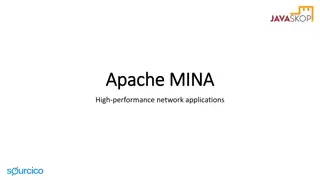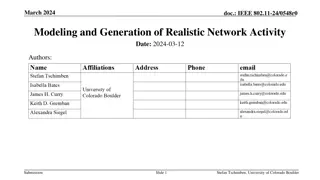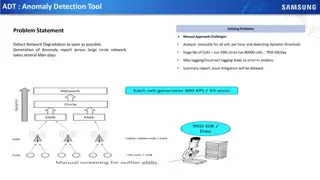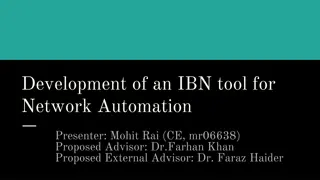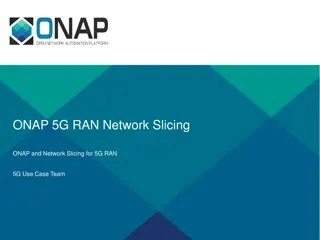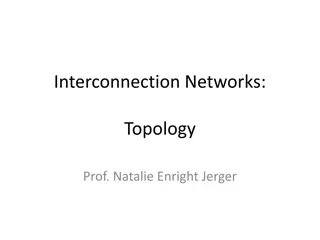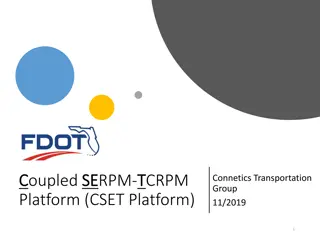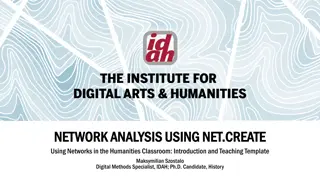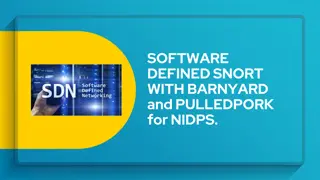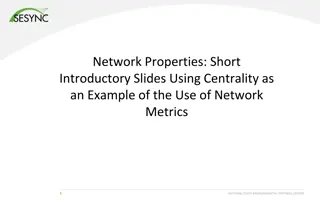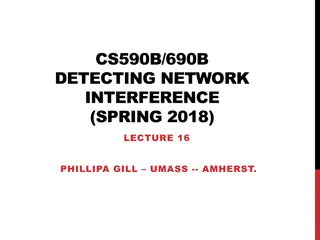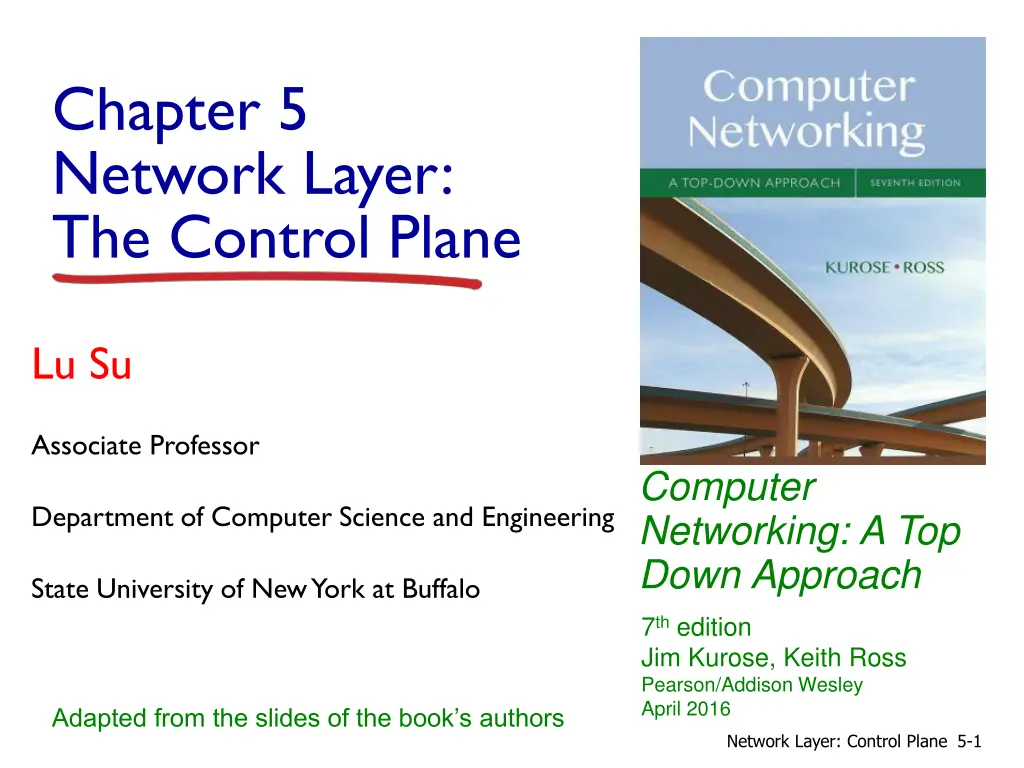
Understanding BGP Routing Protocol in Network Layer
Explore the Border Gateway Protocol (BGP), a crucial inter-domain routing protocol that connects the Internet. Learn about eBGP and iBGP connections, BGP basics, path attributes, and route advertisement policies in AS networks.
Download Presentation

Please find below an Image/Link to download the presentation.
The content on the website is provided AS IS for your information and personal use only. It may not be sold, licensed, or shared on other websites without obtaining consent from the author. If you encounter any issues during the download, it is possible that the publisher has removed the file from their server.
You are allowed to download the files provided on this website for personal or commercial use, subject to the condition that they are used lawfully. All files are the property of their respective owners.
The content on the website is provided AS IS for your information and personal use only. It may not be sold, licensed, or shared on other websites without obtaining consent from the author.
E N D
Presentation Transcript
Chapter 5 Network Layer: The Control Plane Lu Su Associate Professor Computer Networking: A Top Down Approach Department of Computer Science and Engineering State University of New York at Buffalo 7th edition Jim Kurose, Keith Ross Pearson/Addison Wesley April 2016 Adapted from the slides of the book s authors Network Layer: Control Plane 5-1
Chapter 5: outline 5.1 introduction 5.2 routing protocols link state distance vector 5.3 intra-AS routing in the Internet: OSPF 5.4 routing among the ISPs: BGP 5.5 The SDN control plane 5.6 ICMP: The Internet Control Message Protocol 5.7 Network management and SNMP Network Layer: Control Plane 5-2
Internet inter-AS routing: BGP BGP (Border Gateway Protocol): the de facto inter-domain routing protocol glue that holds the Internet together BGP provides each AS a means to: eBGP: obtain subnet reachability information from neighboring ASes iBGP: propagate reachability information to all AS- internal routers. determine good routes to other networks based on reachability information and policy allows subnet to advertise its existence to rest of Internet: I am here Network Layer: Control Plane 5-3
eBGP, iBGP connections 2b 2a 2c 1b 3b 2d 1a 1c 3a 3c AS 2 1d 3d AS 1 eBGP connectivity iBGP connectivity AS 3 gateway routers run both eBGP and iBGP protocols 1c Network Layer: Control Plane 5-4
BGP basics BGP session: two BGP routers ( peers ) exchange BGP messages over semi-permanent TCP connection: advertising paths to different destination network prefixes (BGP is a path vector protocol) when AS3 gateway router 3a advertises path AS3,X to AS2 gateway router 2c: AS3 promises to AS2 it will forward datagrams towards X AS 3 3b AS 1 1b 3a 3c 1a 1c AS 2 2b X 3d 1d BGP advertisement: AS3, X 2a 2c 2d Network Layer: Control Plane 5-5
Path attributes and BGP routes advertised prefix includes BGP attributes prefix + attributes = route two important attributes: AS-PATH: list of ASes through which prefix advertisement has passed NEXT-HOP: indicates specific internal-AS router to next- hop AS Policy-based routing: gateway receiving route advertisement uses import policy to accept/decline path (e.g., never route through AS Y). AS policy also determines whether to advertise path to other neighboring ASes Network Layer: Control Plane 5-6
BGP path advertisement AS3 3b AS1 1b 3a 3c 1a 1c AS2 2b X 3d 1d AS3,X AS2,AS3,X 2a 2c 2d AS2 router 2c receives path advertisement AS3,X (via eBGP) from AS3 router 3a Based on AS2 policy, AS2 router 2c accepts path AS3,X, propagates (via iBGP) to all AS2 routers Based on AS2 policy, AS2 router 2a advertises (via eBGP) path AS2, AS3, X to AS1 router 1c Network Layer: Control Plane 5-7
BGP path advertisement AS3 3b AS1 1b 3a 3c 1a 1c AS2 2b X 3d 1d AS3,X AS2,AS3,X 2a 2c 2d gateway router may learn about multiple paths to destination: AS1 gateway router 1c learns path AS2,AS3,X from 2a AS1 gateway router 1c learns path AS3,X from 3a Based on policy, AS1 gateway router 1c chooses path AS3,X, and advertises path within AS1 via iBGP Network Layer: Control Plane 5-8
BGP messages BGP messages exchanged between peers over TCP connection BGP messages: OPEN: opens TCP connection to remote BGP peer and authenticates sending BGP peer UPDATE: advertises new path (or withdraws old) KEEPALIVE: keeps connection alive in absence of UPDATES; also ACKs OPEN request NOTIFICATION: reports errors in previous msg; also used to close connection Network Layer: Control Plane 5-9
BGP, OSPF, forwarding table entries Q: how does router set forwarding table entry to distant prefix? AS3 3b AS1 1b 1 3a 3c 1a 1c 2 AS2 local link interfaces at 1a, 1d 2b X 3d 1 2 1d AS3,X AS2,AS3,X 2a 2c physical link 2d dest interface X recall: 1a, 1b, 1c learn about dest X via iBGP from 1c: path to X goes through 1c 1d: OSPF intra-domain routing: to get to 1c, forward over outgoing local interface 1 1 Network Layer: Control Plane 5-10
BGP, OSPF, forwarding table entries Q: how does router set forwarding table entry to distant prefix? AS3 3b AS1 1b 1 3a 3c 1a 1c 2 AS2 2b X 3d 1d 2a 2c 2d dest interface X recall: 1a, 1b, 1c learn about dest X via iBGP from 1c: path to X goes through 1c 1d: OSPF intra-domain routing: to get to 1c, forward over outgoing local interface 1 1a: OSPF intra-domain routing: to get to 1c, forward over outgoing local interface 2 2 Network Layer: Control Plane 5-11
BGP route selection router may learn about more than one route to destination AS, selects route based on: 1. local preference value attribute: policy decision 2. shortest AS-PATH 3. closest NEXT-HOP router: hot potato routing 4. additional criteria Network Layer: Control Plane 5-12
Hot Potato Routing AS3 3b AS1 1b 3a 3c 1a 1c AS2 2b X 3d 1d 112 AS3,X 152 2a 2c AS1,AS3,X 263 201 OSPF link weights 2d 2d learns (via iBGP) it can route to X via 2a or 2c hot potato routing: choose local gateway that has least intra- domain cost (e.g., 2d chooses 2a, even though more AS hops to X): don t worry about inter-domain cost! Network Layer: Control Plane 5-13
BGP: achieving policy via advertisements legend: provider network B X W A customer network: C Y Suppose an ISP only wants to route traffic to/from its customer networks (does not want to carry transit traffic between other ISPs) A advertises path Aw to B and to C B chooses not to advertise BAw to C: B gets no revenue for routing CBAw, since none of C, A, w are B s customers C does not learn about CBAw path C will route CAw (not using B) to get to w Network Layer: Control Plane 5-14
BGP: achieving policy via advertisements legend: provider network B X W A customer network: C Y Suppose an ISP only wants to route traffic to/from its customer networks (does not want to carry transit traffic between other ISPs) A,B,C are provider networks X,W,Y are customer (of provider networks) X is dual-homed: attached to two networks policy to enforce: X does not want to route from B to C via X .. so X will not advertise to B a route to C Network Layer: Control Plane 5-15
Why different Intra-, Inter-AS routing ? policy: inter-AS: admin wants control over how its traffic routed, who routes through its net. intra-AS: single admin, so no policy decisions needed scale: hierarchical routing saves table size, reduced update traffic performance: intra-AS: can focus on performance inter-AS: policy may dominate over performance Network Layer: Control Plane 5-16
Chapter 5: outline 5.1 introduction 5.2 routing protocols link state distance vector 5.3 intra-AS routing in the Internet: OSPF 5.4 routing among the ISPs: BGP 5.5 The SDN control plane 5.6 ICMP: The Internet Control Message Protocol 5.7 Network management and SNMP Network Layer: Control Plane 5-17
ICMP: internet control message protocol used by hosts & routers to communicate network- level information error reporting: unreachable host, network, port, protocol echo request/reply (used by ping) network-layer above IP: ICMP msgs carried in IP datagrams ICMP message: type, code plus first 8 bytes of IP datagram causing error Type Code description 0 0 echo reply (ping) 3 0 dest. network unreachable 3 1 dest host unreachable 3 2 dest protocol unreachable 3 3 dest port unreachable 3 6 dest network unknown 3 7 dest host unknown 4 0 source quench (congestion control - not used) 8 0 echo request (ping) 9 0 route advertisement 10 0 router discovery 11 0 TTL expired 12 0 bad IP header Network Layer: Control Plane 5-18
Traceroute and ICMP source sends series of UDP segments to destination first set has TTL =1 second set has TTL=2, etc. unlikely port number when datagram in nth set arrives to nth router: router discards datagram and sends source ICMP message (type 11, code 0) ICMP message include name of router & IP address when ICMP message arrives, source records RTTs stopping criteria: UDP segment eventually arrives at destination host destination returns ICMP port unreachable message (type 3, code 3) source stops 3 probes 3 probes 3 probes Network Layer: Control Plane 5-19
Chapter 5: summary we ve learned a lot! approaches to network control plane per-router control (traditional) logically centralized control (software defined networking) traditional routing algorithms implementation in Internet: OSPF, BGP SDN controllers implementation in practice: ODL, ONOS Internet Control Message Protocol network management next stop: link layer! Network Layer: Control Plane 5-20

